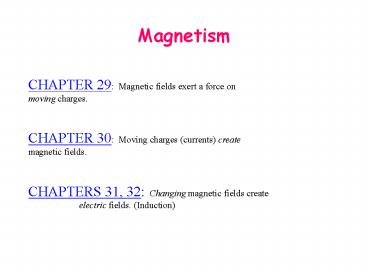Magnetism - PowerPoint PPT Presentation
1 / 17
Title: Magnetism
1
Magnetism
CHAPTER 29 Magnetic fields exert a force on
moving charges. CHAPTER 30 Moving
charges (currents) create magnetic
fields. CHAPTERS 31, 32 Changing magnetic
fields create electric fields.
(Induction)
2
Magnetic fields
- Magnetic poles, forces, and fields
- Force on a moving charged particle
- Force on a current-carrying wire
3
Magnets and Magnetic Forces
Similar model to electrostatics Each magnet has
two poles at its ends.B is the magnetic field
vector (magnetic flux density)
Magnetic poles come in two types, N and S.
Due to the Earths magnetism, a magnet will
tend to rotate until the N end points North.
(the earths north magnetic pole is actually a
south pole)
Forces between magnets are due to the forces
between each pair of poles, similar to the
electrostatic forces between point charges.
4
unlike poles attract
like poles repel
The force gets smaller as distance increases.
5
Magnetic Field B
Magnetic poles produce a field B(think of S as a
charge and of N as a charge)
B
F
The external field exerts forces on poles
F
B
6
Quiz
What is the direction of the force on a magnetic
dipole placed in a uniform magnetic field?
B
7
Magnetic field lines and Magnetic Dipoles
Compass needle (a magnetic dipole) aligns with
B
B
B
compass
N S
S N
Lines point out from N pole
8
Electric charge and Magnetic fields
Hans Ørsted discovered (1819) that moving
electric charges create magnetic fields. Also,
external magnetic fields exert forces on moving
electric charges.
A current loop acts like a magnetic dipole.
9
Define B by the force that an external field
exerts on a moving charge
Charge q moving with velocity , feels a force
(vector product)
F
B
q
v
10
1) 2) ? NO work done! 3) 4) For a negative
charge, the force is in the opposite
direction.
UNITS
Also 1 Gauss (G) 10-4 T
11
Typical Fields
Earths Field 1 x 10-4 T (1 Gauss) Strong
fridge magnet 10-2 T (100 G) Big lab
electromagnet 4 T (40,000 G) Superconducting
magnet up to 20 T (200,000 G)
12
Vector Diagrams
The three vectors F, v, B never lie in a single
plane, so the diagrams are always
three-dimensional. The following convention helps
with drawing the vectors.
For vectors perpendicular to the page, we use
X into the page (tail feathers of arrow)
out of the page (point of arrow)
13
Examples
For a positive charge q moving with velocity v
draw the force vector.
x x x x x x x x x x
x x x x x x
B
B
v
B
v
x
14
B
Wire
current I
L
Current I flows from left to right. In what
direction is the force on the wire?
15
B
The total force on the wire of length L is F
Nqv x B, where N is the number of charges in
length L.
N (number of charges/volume) x (volume) n
x (AL), where A is the cross-sectional area
So, F (nALqv) x B (nqvA)L x B
F I L x B
(straight wire, uniform B)
or,
The vector length L points along the wire in the
direction of the current.
16
Example
up
0.5 x 10-4 T
north
Assume the earths magnetic field is 0.5 x 10-4
T, and points North, 50o below the
horizontal. What is the force (magnitude and
direction) on a straight horizontal power line
100 m long, carrying 400 A
50o
- if the current is flowing North
- if the current is flowing East
17
Solution































